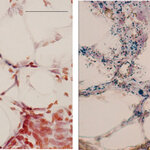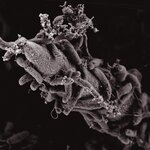Immunology

Maybe fat gets a bad rap. Immune responses matter but when it comes to skin infections, those response may depend greatly upon what lies beneath, according to a paper published in Science. Fat cells below the skin help protect us from bacteria, they write.
Richard Gallo, MD, PhD, professor and chief of dermatology at UC San Diego School of Medicine, and colleagues have uncovered a previously unknown role for dermal fat cells, known as adipocytes: They produce antimicrobial peptides that help fend off invading bacteria and other pathogens.
The human body’s defense against microbial infection…

Methicillin-resistant Staphylococcus aureus (MRSA) infection has gotten a lot of attention. It is caused by a strain of staph bacteria that's become resistant to the antibiotics commonly used to fight it, but antibiotic resistance is not new. For as long as antibiotics have been manufactured (and nature shows evidence of it well before that) resistance evolves.
Science has to stay a step ahead in the interests of public health and a new paper details a newly discovered antibiotic that eliminates pathogens without encountering any detectable resistance, which holds great promise for…

Cholera is characterized by acute watery diarrhea resulting in severe dehydration and occurs when the bacterium Vibrio cholerae infects the small intestine.
How does it happen?
École polytechnique fédérale de Lausanne (EPFL) scientists have found that V. cholerae uses a tiny spear to stab and kill neighboring bacteria - even of its own kind - and then steal their DNA. The V. cholerae predatory molecular killing device is a spring-loaded spear that is constantly shooting out. This weapon is called the "type VI secretion system" (T6SS) and is known to exist in many types of…

Elderly patients admitted to intensive care units are about 35 percent more likely to die within five years of leaving the hospital if they develop an infection during their stay.
The upside to this finding is that preventing two of the most common health care-associated infections - bloodstream infections caused by central lines and pneumonia caused by ventilators - can increase the odds that these patients survive and reduce the cost of their care by more than $150,000, according to a study in American Journal of Infection Control.
The study looked at outcomes for 17,537 elderly…

Folk wisdom has long held that people are more likely to catch a cold in cool-weather or damp conditions but some recent claims have disputed that and found the virus transmits just as often regardless of temperature. This has been latched onto by people who advocate less energy usage in order to minimize fossil fuel usage.
But the rhinovirus, the most frequent cause of the common cold, can reproduce itself more efficiently in the cooler temperatures found inside the nose than at core body temperature, according to a new study. That means cold is bad.
The focus…

Cold and damp is bad, no matter what you may have heard recently about it making no difference. The common cold virus reproduces itself more efficiently in the cooler temperatures found inside the nose than at core body temperature, confirming the popular-yet-recently-contested notion that people are more likely to catch a cold in cool, damp conditions.
Scientifically it is known that the rhinovirus, the most frequent cause of the common cold, replicates more readily in the slightly cooler environment of the nasal cavity than in the warmer lungs but, the focus of prior studies has…

The enzyme signal peptide peptidase-like 3 (SPPL3) is known to 'cut' proteins - they cleave the peptide bonds in the polypeptides that make up proteins - but it turns out that it works to activate T-cells, the immune system's foot soldiers - without cutting proteins.
Because its structure is similar to that of presenilin enzymes, which have been implicated in Alzheimer's disease, the researchers believe their findings could shed more light on presenilin functions, in addition to providing new insight into how the immune system is controlled.
"No one could have predicted that SSPL3 was…

The most recent outbreak of the Ebola virus disease occurring in West Africa may have originated from contact between humans and virus-infected bats, according to a new study in EMBO Molecular Medicine, which identifies insectivorous free-tailed bats as plausible reservoirs and expands the range of possible Ebola virus sources to this type of bats.
The virus that spread from Meliandou into other areas of Guinea and Sierra Leone, Liberia, Nigeria and Senegal, represents the largest ever-recorded Ebola outbreak killing 7,800 people as of December 17th 2014.
Ebola virus disease epidemics…

Binge drinking in young, healthy adults significantly disrupts the immune system, according to a new epidemiology paper.
Depending on their weight, study participants drank four or five shots of vodka. Twenty minutes after reaching peak intoxication, their immune systems revved up. But when measured again, at two hours and five hours after peak intoxication, their immune systems had become less active than when sober. Binge drinking is also linked epidemiologically with increases the risk of falls, burns, gunshot wounds, car accidents and other traumatic injuries. One-third of trauma patients…

Hutchinson-Gilford progeria syndrome is a genetic condition in children that is characterized by dramatic, rapid appearance of aging. Affected children typically look normal at birth and in early infancy but grow more slowly than other children and develop characteristic facial appearances seen in some elderly people, along with hair loss, aged-looking skin and a loss of fat under the skin - subcutaneous fat. First described in 1886, it occurs in about 1 in 4 million newborns worldwide.
Most Hutchinson-Gilford Progeria Syndrome (HGPS) patients carry a mutation that produces a defective form…